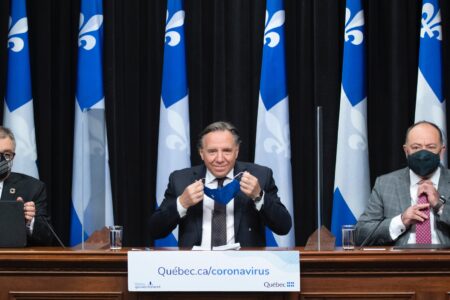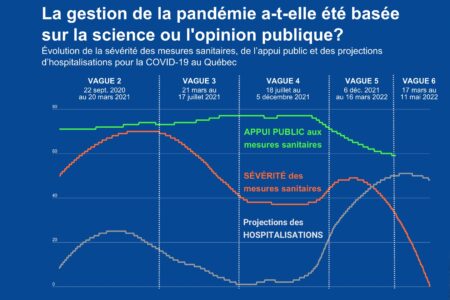
No, it’s not the virus’s fault as Ontario’s deputy Chief Medical Officer of Health Dr. Barbara Yaffe suggested earlier this month.
Observing the disastrous response to the second wave of the pandemic in Ontario has been unnerving – as a resident, parent and federalism scholar. To be fair, the public health crisis caused by COVID-19 confronts governments with a complex policy challenge. But the dire situation we are in today was not inevitable. The pandemic has revealed a troubling failure of political leadership on many fronts in provinces like Ontario and Alberta. It’s time for the federal government to take a more active stance, and to press premiers to join forces with a pan-Canadian emergency response.
While experts were ringing alarm bells all over in the fall, we observed an appallingly overwhelmed provincial government in Ontario. In mid-November, Ontario’s Chief Medical Officer of Health Dr. David Williams still rambled on about the possibility of the entire province being in a green zone by Christmas. Statistically impossible, the response by biostatistician Ryan Imgrund.
On Dec. 15, Premier Ford was still “seeing a plateau per se.” Shortly thereafter, the government announced a lockdown “light,” kicking in on Boxing Day, a decision that predictably contributed to the current spike in case numbers, with tragic consequences.
By Jan. 21, the province registered already 1,084 deaths, the second highest monthly death rate since the pandemic started. In long-term care (LTC) homes, infection and mortality growth rates have accelerated significantly since December 2020. According to Dr. Nathan Stall of Mount Sinai Hospital, outbreaks disproportionally affect Ontario’s for-profit homes with “nearly twice as many residents infected … and 78 per cent more resident deaths … compared with non-profit homes.”
As the province has been unable to manage existing problems like the crisis in LTC homes and uncertainty of the spread in schools and workplaces, a new threat has arrived with the variant of the virus. There is little doubt the situation is getting out of control.
As Europe wrestles with a similar challenge, more than 300 scientists called for a co-ordinated pan-European strategic response, published in The Lancet on Dec. 18. Viola Priesemann, a senior researcher at the Max Planck Institute for Dynamics and Self-Organization in Germany, and her collaborators “urge governments throughout Europe to agree on clearly formulated common goals, co-ordinate their efforts, develop regionally adapted strategies to reach the goals, and thereby work resolutely towards low case numbers.”
The federal government is in a position of fiscal and political strength. Evoking emergency powers, as some observers have suggested, is therefore neither advisable nor necessary.
This call should inspire a similar initiative in Canada. The disastrous handling of the pandemic has paved the way for the Trudeau government to step in and develop a plan for a bold concerted effort to bring the case numbers down, to keep them low and to develop a long-term vision.
The federal government is in a position of fiscal and political strength. Evoking emergency powers, as some observers have suggested, is therefore neither advisable nor necessary. Instead, the government should demonstrate leadership through a less invasive yet still determined approach.
First, it should demand accountability. The federal government transferred billions of dollars in contingency funds to the provinces. In early December 2020, however, the Ontario Financial Accountability Office revealed that the Ford government was still sitting on $12 billion in unspent federal reserves. It’s funding that could have been proactively used to create safer schools and LTC homes, or to introduce paid sick leave.
Second, the feds should consider placing conditions on future transfers. Since the 1970s, most federal transfers to the provinces have become de facto unconditional. Even in the field of health care or social assistance, the provinces have large discretion in terms of how they spend federal monies. But extraordinary times require extraordinary measures: A temporarily limited return to more conditionality in order to crush and contain COVID-19 case numbers across the country is warranted.
Third, the federal government should actively promote closer and deeper intergovernmental co-operation, especially in areas that fall within the exclusive jurisdiction of the provinces. As the Atlantic provinces have taught us, effective co-operation is a critical condition for managing a public health challenge like COVID-19. The four provinces not only created the “Atlantic bubble,” but were also more determined than all other provinces to enact strict measures early on, before infection rates spiralled out of control.
But this “horizontal” approach to co-ordination across political boundaries won’t work in a pan-Canadian context. Instead, the federal level needs to orchestrate “vertically” intergovernmental co-operation in the shadow of hierarchy.
The federal government must now set the agenda for a more uniform approach throughout the country. Look to Germany as an example. The federal level and the Länder (or states) in Germany were reluctant to adopt more far-reaching measures despite the recommendations of most public health experts. Only after rates of infection, hospitalization and deaths climbed following the holiday break were exiting rules tightened in early January. The latest intergovernmental agreement in Germany includes mobility restrictions for residents in hotspots and explicitly ruling out any leisure travel. In addition, the Merkel government commits to expand income transfers, ensuring employees stay at home when feeling symptoms.
In the 1970s, American political scientist Martin Landau praised federalism for its redundancy. If malfunction occurs on one level of government, it can be made up by another level, thereby enhancing system reliability through stabilization feedback. In this spirit, it’s time for the federal government to take on more responsibility in order to contain the pandemic, and to protect the fundamental human rights of vulnerable demographics. Prime Minister Justin Trudeau seems to sense the urgency for action. Now he needs to act.
Photo: The Eaton Centre in Toronto, Dec. 19, 2020. Shutterstock.com, by Camillo Clauser.








